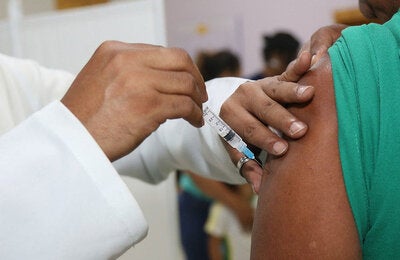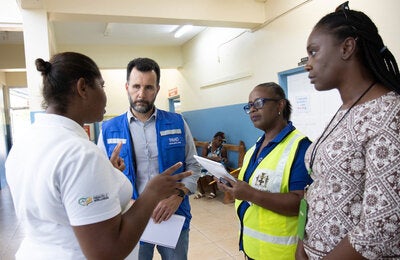Geneva/Washington D.C., 31 May, 2018 (PAHO / WHO) - Tobacco use has declined markedly since 2000, both globally and in the Region of the Americas, but the reduction is insufficient to meet global targets aimed at protecting people from death and suffering from cardiovascular and other non-communicable diseases (NCDs). Currently, over a third of countries in the Americas are not implementing a single tobacco control measure.
For today's World No Tobacco Day 2018, WHO has joined with the World Heart Federation and many other allies to raise awareness on the link between tobacco and cardiovascular diseases (CVD), which are the world's leading causes of death. CVD are responsible for 44% of all NCD deaths, or 17.9 million deaths annually in the world, including 2 million deaths in the Americas.
Tobacco use and second-hand smoke exposure are the major causes of CVD, including heart attacks and stroke, contributing to approximately 3 million deaths per year globally. But evidence shows there is an alarming lack of knowledge and awareness that tobacco is a major risk for conditions like stroke and heart attack.
"Political leaders must do more to raise awareness and protect people from the harms of tobacco," says Dr. Tedros Adhanom Ghebreyesus, WHO Director-General. "I urge them to join the global movement to promote health and protect people from avoidable suffering and deaths, especially from tobacco use."
In order to reduce premature deaths caused by tobacco, Dr. Carissa Etienne, Director of the Pan American Health Organization (PAHO), says governments must urgently implement the measures outlined in the WHO Framework Convention on Tobacco Control (WHO FCTC). "Higher tobacco taxes, bans on tobacco advertising and promotion, smoke free environments in all public and work places, and large and graphic health warnings on tobacco packages can all help improve health."
World off track to meet tobacco reduction target, with exception of the Region of the Americas
On this World No Tobacco Day, WHO issued its Global Report on Prevalence of Tobacco Use (2000-2025). Tobacco kills over 7 million people each year, despite the steady reduction in tobacco use globally. The report shows the pace of action in reducing tobacco demand and related death and disease is too slow and not keeping up with global and national commitments to control tobacco use. The report also shows that the target of a 30% reduction in tobacco use by 2025 among people aged 15 and older is not on track to being met at the global level, with the current pace of decline indicating only a 22% reduction by that time. The Region of the Americas is the only exception; the current projections indicate that the target will be reached by 2025.
Cardiovascular disease and tobacco use in the Americas
In the region of the Americas, tobacco is responsible for 900,000 deaths per year, including 72,000 premature deaths caused by second-hand exposure to tobacco smoke, and associated with 11% of the deaths caused by CVD.
The WHO FCTC, which came into force in 2005, calls on its Parties to take several measures to reduce demand and supply for tobacco products. These interventions include protecting people from exposure to tobacco smoke; banning tobacco advertising, promotion and sponsorship; banning sales to minors; requiring health warnings on tobacco packaging; promoting tobacco cessation, and increasing tobacco taxes.
"There is compelling evidence from countries that have implemented tobacco reduction measures, that results can be seen quickly," says Dr. Adriana Blanco, Unit Chief of Risk Factors and Nutrition for the Department of Noncommunicable Diseases and Mental Health at PAHO. "You do not have to wait 10 years to see the impact on a population's health, especially in relation to cardiovascular diseases. This is why it is so important that countries accelerate the implementation of the FCTC."
Latest findings on Prevalence of Tobacco Use
- Change in smoking: The global prevalence of smokers has declined, but the absolute number of smokers has barely changed since the beginning of this century due to population growth. There are 1.1 billion adult smokers in the world today, and at least 367 million smokeless tobacco users. In the Region of the Americas there are 132 million smokers. The prevalence of smokers in the region has declined from 28.0% in 2000 to 17.4% in 2015.
- Smokeless tobacco: in 2015, 6.5% of the global population aged 15 and over used smokeless tobacco (8.4% for males and 4.6% for females).
- By sex: For males aged 15 and over globally, 43% smoked tobacco in 2000 compared to 34% in 2016, while 11% of females smoked in 2000, compared to 6% in 2016. In the Region of the Americas the prevalence for males in 2000 was 33.4% compared to 22% in 2015, and, among females, 22.6% in 2000 compared to 12.9% in 2015.
- Country response: Over half of all WHO Member States have reduced demand for tobacco, and almost one in four are likely to meet the 30% reduction target by 2025. But countries must do more to monitor tobacco use in all its forms - not only cigarette smoking. Currently, one in four countries have insufficient data to monitor their tobacco epidemic.
- Youth: Worldwide, about 7%, or just over 24 million children aged 13-15, smoke cigarettes (17 million boys and 7 million girls). About 4% of children aged 13-15 years (13 million) use smokeless tobacco products. In the Region of the Americas about 10% or 4.6 million children aged 13-15, smoke cigarettes (2.4 million boys and 2.2 million girls). About 2% of children aged 13-15 years (1.2 million) use smokeless tobacco products.
- Developing countries: Over 80% of tobacco smokers live in low- and middle-income countries (LMICS). Prevalence of tobacco use is decreasing more slowly in LMICs than in high-income countries.
Editor's note:
Countries have committed to reducing premature death from NCDs by one-third by 2030 as part of the Sustainable Development Goals, as well as implementing the WHO FCTC.
The WHO FCTC entered into force in February 2005 and has today 181 Parties covering more than 90% of the world's population.



